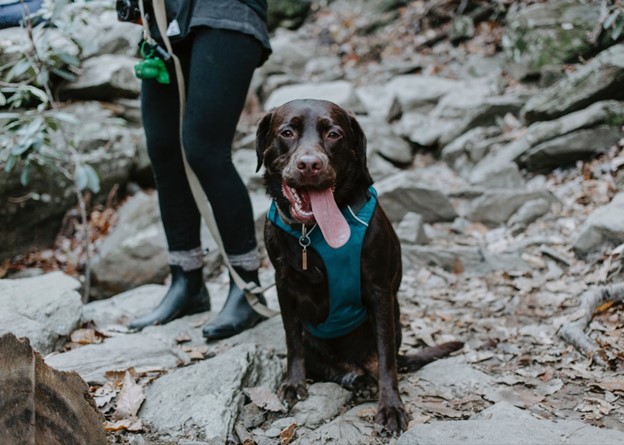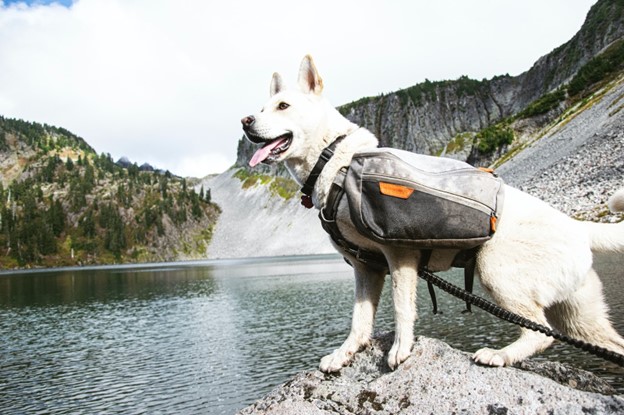Hiking with your dog can be an incredibly rewarding experience. It allows you and your furry companion to explore the great outdoors, bond, and stay active together.

Photo by Wade Austin Ellis on Unsplash
While the allure of hiking with a dog is undeniable, not all dog breeds are built the same, and the trail’s demands vary. Some breeds are naturally more suited for long, strenuous hikes, while others might be better off with short, less challenging jaunts.
For instance, breeds like the Siberian Husky, Border Collie, and Australian Shepherd are known for their endurance and agility, making them excellent hiking companions.
On the other hand, brachycephalic breeds, like Bulldogs or Pugs, might struggle due to their respiratory structure, especially on tougher terrains or in hotter climates.
And then, there are several common mistakes that dog owners make when taking their dogs on hiking adventures. Let’s get straight into the weeds:
Mistakes to Avoid When Hiking With Your Dog
To ensure a safe and enjoyable hiking experience for both you and your dog, it’s important to avoid common mistakes:
Inadequate Preparation: Failing to acclimate your dog to long walks or rugged terrain before a hiking trip. The first long and challenging hike shouldn’t be an actual adventure.
Ignoring Weight Limitations: Overloading your dog with a heavy pack. Ensure the weight doesn’t exceed 20-25% of the dog’s body weight.
Overlooking Paw Protection: Not investing in dog booties or failing to check pads regularly for cuts, thorns, or wear. Rough terrain can be abrasive on their pads.
Misjudging Water Needs: Dogs need more water than you’d expect, especially in heat. Failing to bring enough water or not knowing nearby water sources can be detrimental.
Ignoring Trail Rules: Some trails have leash laws or may be off-limits to dogs. Disregarding these can endanger other hikers and local wildlife.
Skipping Tick/Flea Prevention: In certain areas, failing to administer tick and flea prevention means exposing your dog to harmful pests that can transmit diseases.
Overexertion in Heat: Dogs can’t sweat like humans. Hiking during peak heat without adequate breaks and shade can lead to heatstroke.
Inappropriate Gear: Using a regular collar instead of a harness can strain your dog’s neck. Likewise, a retractable leash isn’t ideal for hiking due to the lack of control.
Lack of Training: Hiking demands dogs to obey commands like ‘stay’ or ‘come’ for their safety. Not training your dog adequately can expose them to risks.
Ignoring Dietary Needs: Failing to provide a high-protein snack or meal after a strenuous hike can delay muscle recovery for your dog.
Not Planning for Emergencies: Not carrying a first-aid kit designed for dogs or being unaware of the closest vet or emergency contact can be fatal in case of injury.
Forgetting Etiquette: Not picking up after your dog or allowing them to approach every hiker/dog they encounter can be a nuisance and degrade the trail environment.
Experts know that hiking with a dog is not merely an extension of the usual walk in the park.
Less Common Knowledge
Not Conditioning Dog’s Carrying Ability: Even if a dog can carry a certain weight, they might not be conditioned to carry it over long distances or uneven terrains. Gradually increase the weight and distance in the pack during practice hikes.

Photo by Jamie Pilgrim on Unsplash
Ignoring Altitude Changes: Just like humans, dogs can be affected by altitude sickness. Rapid ascent to high altitudes without acclimatization can be harmful.
Using Human Bug Sprays: DEET, commonly found in human insect repellents, is toxic to dogs. It’s crucial to use only pet-safe bug repellents.
Disregarding Local Fauna: Not being aware of local wildlife and their habits. For instance, certain areas might have snakes or predators which could pose threats if not handled cautiously.
Not Understanding Dog’s Body Language: Ignoring subtle signs of distress, fatigue, or discomfort, which could be indicative of a bigger problem. This includes limping, excessive panting, reluctance to move, and more.
Improper Hydration Methods: Using wide, shallow containers for water can cause a dog to drink too fast, possibly leading to vomiting. A deep, narrow container is ideal.
Forgetting Night Safety: If you’re caught out after dark, not having reflective or LED gear for your dog can make them invisible, posing a danger especially in shared spaces or when crossing roads.
Not Testing New Gear at Home: Introducing new gear directly on the trail without letting the dog get accustomed to it at home first can cause discomfort or anxiety.
Neglecting Mental Stimulation: Focusing solely on the physical aspect of the hike and not including activities or toys that stimulate your dog’s mind can make the journey monotonous for them.
Assuming All Water is Safe: Just because a stream looks clean doesn’t mean it’s free from parasites. Always carry a portable water purifier or offer your dog water from trusted sources.
Using the Same Routine: Dogs benefit from varied experiences. Hiking the same trail repeatedly can make them less adaptable to new terrains or environments.
Steep Adventure Example: Navigating the Lesser-Known Dangers of the Appalachian Trail
The Appalachian Trail (AT) is one of the most iconic long-distance hiking paths in the world, offering a mix of majestic views, challenging terrains, and unique wildlife encounters.
depositphotos_52639459-stock-photo-appalachian-trail.jpg
But with these wonders come dangers, especially when trekking with a canine companion.
Trail Basics:
Location: The Appalachian Trail stretches across the eastern United States.
Length: Approximately 2,190 miles (3,524 km).
Starts: Springer Mountain in Georgia.
Ends: Mount Katahdin in Maine.
Hazards and Dangerous Elements:
Unpredictable Weather: The Appalachian Trail (AT) offers a unique topographical challenge as it runs through 14 states and crosses various climate zones.
Photo by Fabrizio Conti on Unsplash
Sweltering Heat: During summer months, especially in the southern sections of the trail, temperatures can soar. In 2019, for example, a heatwave saw temperatures hitting nearly 100°F (38°C). For dogs, such extreme heat is particularly dangerous. Unlike humans, they don’t sweat and can suffer from heatstroke rapidly, especially if they’re heavily coated breeds.
Torrential Rains: The AT frequently witnesses heavy rainfall. There have been instances where hikers were caught in downpours lasting days. Wet fur combined with cooler temperatures can lead to hypothermia in dogs, making it essential for hikers to carry waterproof gear not just for themselves but also for their furry companions.
Snow and Ice at Higher Elevations: Even during spring and fall, the higher elevations, particularly in the White Mountains of New Hampshire or parts of Maine, can have snow and ice-covered paths.
depositphotos_52502505-stock-photo-fog-over-the-appalachian-mountains.jpg
In 2018, a hiker reported encountering waist-deep snow in certain sections, making navigation almost impossible.
Photo by Will Swann on Unsplash
For dogs, icy trails can lead to frostbite, especially on their paw pads, or they can slip and injure themselves.
Difficult Terrain: The AT is not a consistent, smooth path. Its diversity is its beauty, but also its challenge.
Rocky Paths: Some parts of the trail, like Pennsylvania’s notorious “Rocksylvania” section, are incredibly rocky. Dogs can easily cut their paws or become exhausted trying to navigate these stretches.
Steep Climbs: Areas like the Mahoosuc Notch are known for their challenging and steep terrain. Such sections can be treacherous for dogs, potentially leading to pulled muscles or other injuries.
Rapidly Flowing Streams: The trail crosses multiple streams. After heavy rains streams can swell rapidly, and what was once a small brook can turn into a roaring river.
Ticks and Lyme Disease: The AT passes through forests and tall grass areas, ideal habitats for ticks.
Ticks are not just an itching nuisance. They carry Lyme disease, a bacterial infection that can have severe symptoms in both humans and dogs.
Symptoms in dogs include fever, swelling of joints, and lethargy. Preventative measures, such as tick repellents and regular tick checks, are vital to ensure the safety of both the hiker and their pet.
Dangerous Fauna on the AT:
The Appalachian Trail (AT) winds through a vast and diverse ecosystem teeming with various wildlife. While most of these animals are harmless or shy away from humans, certain encounters can be hazardous, especially when hiking with dogs. Here’s a deeper look:
Bears:
Potential dangers: Black bears are the primary species found along the AT. A curious bear, especially a mother with cubs, can be dangerous if they feel cornered or threatened. There have been instances where dogs, due to their natural instincts, have either chased bears or barked at them, leading to a protective or defensive reaction from the bear.
Prevention: Ensure your food and scented items are stored properly, preferably in bear canisters or hung away from your campsite using the PCT method. Train your dog to respond immediately to commands so you can control their behavior during potential bear encounters. Avoid hiking during dawn or dusk when bears are most active.
Snakes:
Potential dangers: The copperhead and timber rattlesnake are among the venomous species on the AT. These snakes tend to be camouflaged and might be sunning themselves on the trail or hiding under rocks and leaves. A dog’s natural curiosity can lead them to sniff or paw at snakes, leading to bites.

depositphotos_170790882-stock-photo-black-timber-rattlesnake.jpg
Prevention: Keep your dog on a leash and stay on the trail, avoiding tall grass and rock piles. Train your dog to “leave it” or “stay away” from snakes or other potential hazards. Always be attentive and watch your step and your dog’s path. Familiarize yourself with the local veterinary clinics along or near the AT route and have their contact information handy.
In case of a bite: If your dog is bitten by a venomous snake, it’s crucial to act promptly. Restrict your dog’s movement; this might involve carrying them if they’re a smaller breed. Do not attempt home remedies, such as cutting the wound or trying to suck out the venom, as they can exacerbate the situation.
Wild Boars:
Potential dangers: These animals, found mainly in the southern sections of the AT, are known to charge at perceived threats, especially if they have young ones. Dogs can inadvertently provoke boars by barking or chasing.
Prevention: Maintain a safe distance if you encounter wild boars. Ensure your dog is leashed and has reliable recall training. If you see signs of wild boars (like dug-up ground), be extra vigilant.
Other Wildlife:
Potential Dangers: The AT is home to various wildlife. For example, porcupines’ quills are barbed and can embed deeply in a curious dog’s nose, mouth, or paws. Removal can be challenging and painful.

depositphotos_68490295-stock-photo-indian-crested-porcupine-on-grass.jpg
Prevention: Monitor your dog’s interactions with wildlife closely. Keep them on a leash or ensure they’re well-trained for off-leash hiking. Equip yourself with knowledge of local fauna so you can identify potential threats.
Final Thoughts:
Hiking with your dog can be an enriching experience, but it’s imperative to be aware of the lesser-known dangers.
And preparation is key. Arm yourself with knowledge, carry a comprehensive first aid kit tailored to canines, and always prioritize the safety of both yourself and your furry companion.
Every serious hike is a test of endurance and wit, but with caution, it promises an adventure of a lifetime.



Leave a Reply